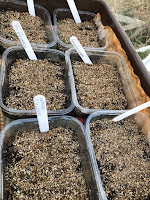 |
| Winter honeysuckle |
Other plants that have started to green up include the
gooseberries – bare and brown one day, and almost the next, bright green –
followed quickly by the other soft fruit.
I’ve been doing some manual ‘greening up’, of the lawn near
the greenhouse. It has had a few bare
patches for a while now, the result of my intermittent attempts to weed out some
of the creeping potentilla, an innocuous-looking little plant which has a
tap-root up to 30cm/1ft deep and throws out long runners through the grass and
into the flower beds, if allowed. My
attempts to curb its enthusiasm aren’t having much success (and are leaving
their mark on the lawn). Then last year we
had to have the drains relaid, and the lawn still bears the considerable scars from
the work. Next week we’re having some
hard landscaping done, including a small area of hardstanding next to the
summerhouse; as it happens, that area, currently part of the lawn, has some of
the most weed-free grass in the garden, and it seems a pity to have it dug up
and carted away by the workmen. I’ve
been lifting turves from there and trying to bed them into the bare patches by
the greenhouse. There’s still a short
stretch needing to be done – I’ll have to find some more decent-quality lawn
elsewhere! – and I suspect that the newly laid area is going to be rather lumpy
and uneven for a while, but it does look a little better than it did.
The other predominant colour in the garden at the moment is
yellow – the daffodils are at their peak, and the doronicums are
starting to bloom. I’m still waiting for
the little daffs in the window-box to flower, though the ‘Blue Pearl’ crocuses
are doing a good job of brightening up the window. And yesterday I was stopped in my tracks half-way
across the garden when I caught the scent of violets on the breeze; the
sprawling and untidy patch of violets in the bottom border is in bloom. It’s amazing how such a tiny flower can pack
such an olfactory punch. A small posy is
now on the table indoors.
 |
| 'Blue Pearl' crocuses in the windowbox |
 |
| A posy of violets |
The birds are also moving into full spring mode. The sparrows and robins are collecting nest
material and taking it into the long hedge, where the blackbirds already have a
thriving nest; Mr Blackbird has been gathering little worms and grubs to feed
their first nestlings (he particularly appreciated my lawn-digging). One, and possibly two, coal tits have been
about; we occasionally see one on the seed feeder, further down the garden, but this one has discovered
the fatball container and has been coming to the patio to bathe. I hope they’re nesting nearby.
And on our weekly shopping trip yesterday we saw blackthorn
flowering in the hedges, and the first lambs in the fields. The weather is forecast to be on the chilly
side for a while yet – the proverbial ‘blackthorn winter’ – but spring is
definitely coming!







